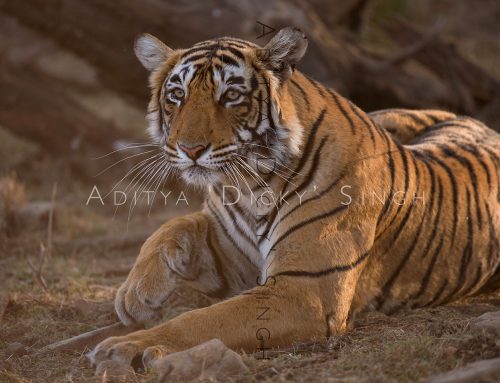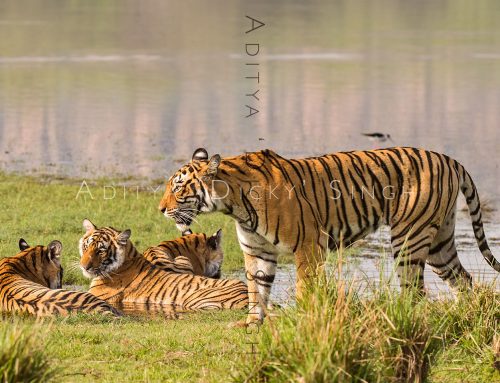Geographical spread of tigers
Tiger is an Asian cat that till just a few centuries ago was widespread nearly all over Asia, from the Caucasian mountains and Caspian Sea to the eastern shores of Asia, including the icy Siberia and the tropical islands of Southeast Asia. In the last one and a half century and more so in the last few decades, habitat destruction and hunting decimated their population in the original range. They are now restricted to a few isolated pockets in southern, eastern and southeastern Asia.
The original range of tigers was an extremely large area with a great diversity of climate and habitats. Tigers had adapted well to this diversity. The adaptations included some minor physical changes besides behavioral ones. As a result of these minor adaptations they are classified into different sub species or geographical “races” that can successfully breed with other such sub species or “races”.
Nine different sub species of tigers are recognized and three of these are extinct.
Bengal tiger
Panthera tigris tigris: is the most common of all the tiger sub species and is found in pockets (large and small) in India, Nepal, Bhutan and Bangladesh. Within this range it survives in a wide variety of habitats including mountains of Bhutan, arid forests of Rajasthan, the islands of Sundarbans delta to the tropical rainforests of Western Ghats. They are second largest of all sub species, after the Amur tigers.
Indochinese tiger
Panthera tigris corbetti: is the third most numerous sub species of all. They are restricted to the forests of Burma, Thailand, Laos, Cambodia and Vietnam. They are smaller in size than the Amur and Bengal subspecies but larger than the other Southeast Asian sub species. In the recent decades habitat destruction and poaching of tigers and the prey species took a big toll on their population.
Malayan tiger
Panthera tigris jacksoni: they were classified under the Indochinese sub species till 2004, when they were declared a different sub species on the basis of genetic diversity. They are restricted exclusively to the Malay Peninsula and are the smallest of the mainland tigers, slightly smaller than the Indochinese tiger.
Sumatran tiger
Panthera tigris sumatrae: is the only surviving sub species in the islands of southeast Asia and is genetically more distinct that all the other sub species. It is also the smallest of all surviving sub species. They are found only in the island of Sumatra in Indonesia.
Amur tiger
Panthera tigris altaica: is the largest and northernmost of all tiger sub species. Their range, once wide spread, is now restricted to southeast Siberia along the Amur River. As a result of their adaptation to the icy cold they have thick fur, a layer of fat below it (which is partly responsible for their large size), are lighter colored and have fewer stripes than the other sun species.
South China tiger
Panthera tigris amoyensis: this the most critically endangered subspecies of tiger and is widely believed to be extinct in the wild. There are about 50 captive tigers in China but all of these are descendents of 6 individuals.
Besides the 6 sub species that still exist, there were 3 more sub species that have gone extinct.
Bali tiger
Panthera tigris balica: was confined to the small island of Bali in Southeast Asia. They were the smallest of all tiger subspecies and the firs ones to be hunted to extinction. The last one was believed to be killed in 1930s. They were never held in captivity.
Javan tiger
Panthera tigris sondaica: was found in the heavily populated Indonesian island of Java and were very similar to the Sumatran tiger. They had been on the verge of extinction from the 1950s onwards but the last confirmed specimen was sighted in 1979.
Caspian Tiger
Panthera tigris virgata: also known as the Persian tiger or Turanian tiger was the westernmost tiger sub species, found in Iran, Iraq, Afghanistan, Turkey, Mongolia, Kazakhstan, the Caucasus, Tajikistan, Turkmenistan, and Uzbekistan until it became extinct in the 1950s. Recent genetic research suggests that the animal was largely identical to the Siberian tiger and some experts now believe that is was a western population of Amur sub species.

The original range of tigers was very diverse in all respects. However, there are three essential requirements for tigers to survive in a habitat and these are adequate cover of vegetation, sustainable prey density and proximity to water sources. Without these three conditions tigers just cannot survive in a habitat. Tiger’s camouflage is best adapted for ambush hunting and without adequate cover it would be impossible for them to get close enough to prey species for successful hunts. They need good cover of vegetation not only to hunt but also to breed successfully. They need a high and sustainable density of prey to fulfill their present and future requirement of food. Many experts believe that poaching of tiger’s prey species poses a bigger threat to tiger’s survival than the poaching of tigers themselves. Besides cover and prey, tigers are highly dependent on water and cannot exist in habitats that do not have perennial water sources.




